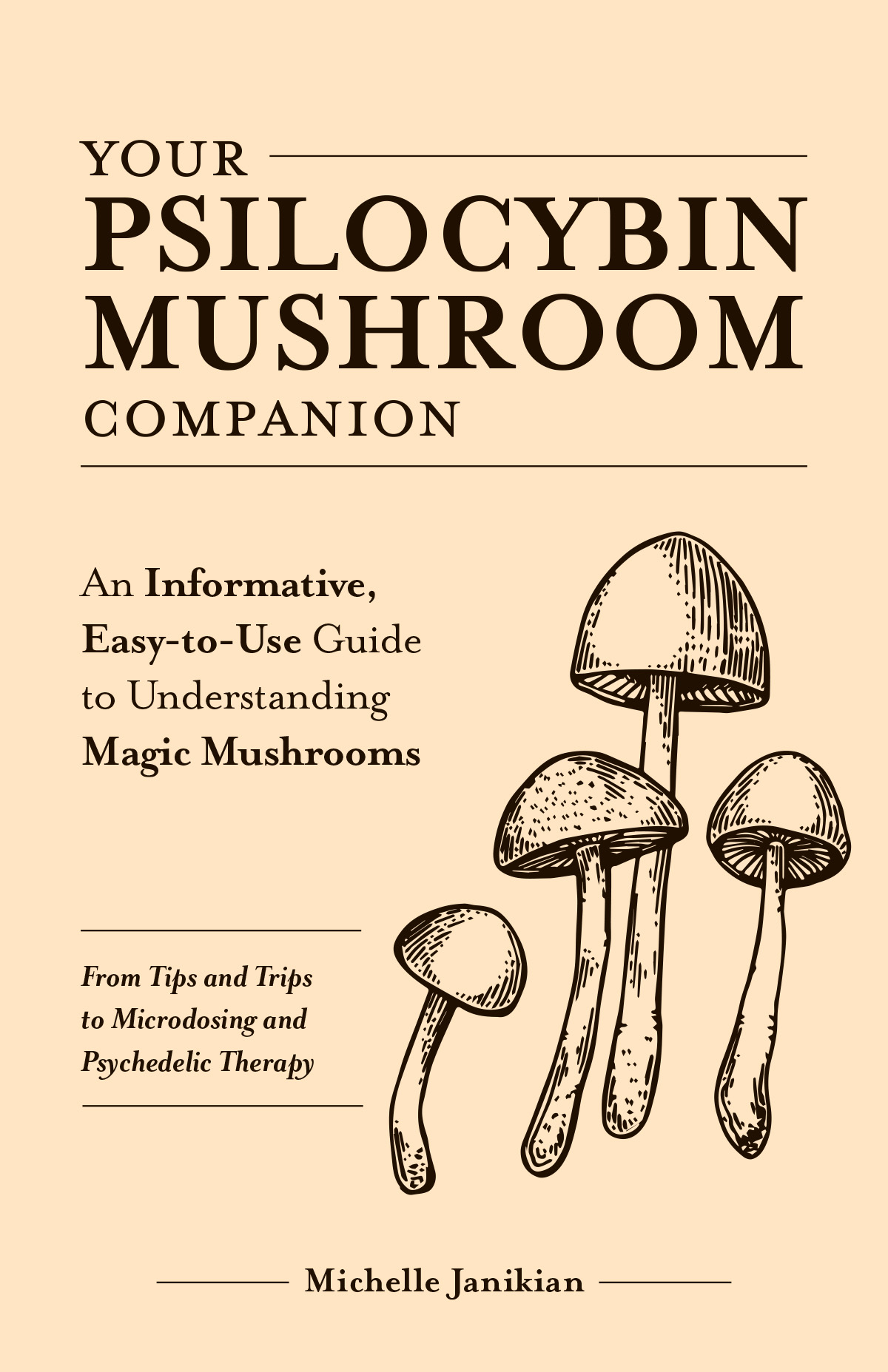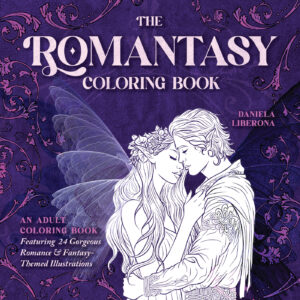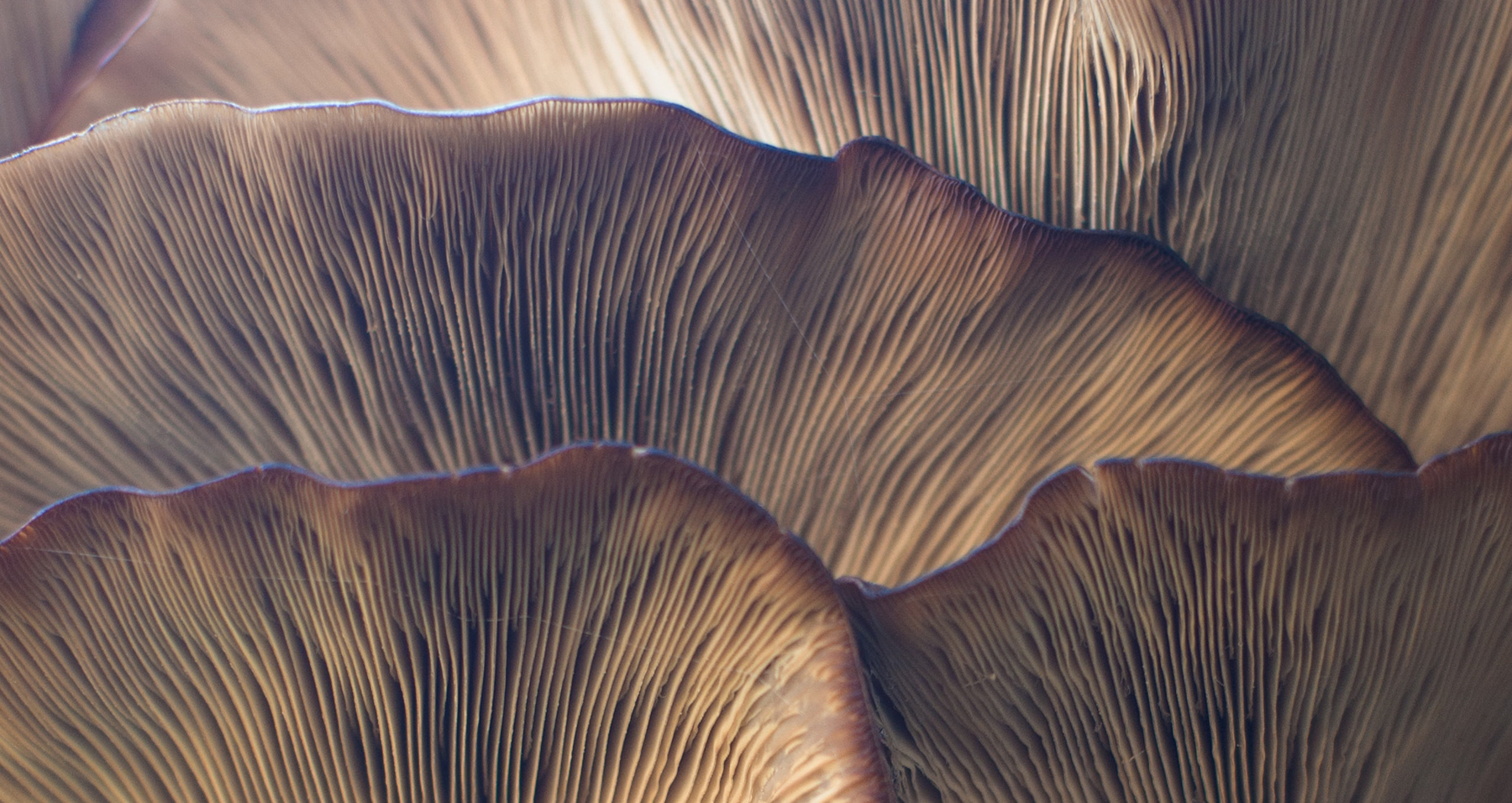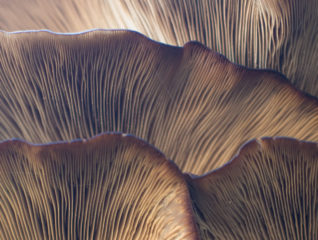
What is Psilocybin and Why Use Mushrooms?
- Book Sample /
- Mind, Body, Spirit
- Self-Help
WHAT IS PSILOCYBIN AND WHY USE MUSHROOMS?
This is the first chapter of Your Psilocybin Mushroom Companion by Michelle Janikian
WHAT IS PSILOCYBIN?
Nature is filled with extraordinary compounds. Plants produce all kinds of secondary alkaloids, often as a defense mechanism to protect themselves. Yet, scientists are still unsure of the purpose of one of Mother Nature’s most mysterious substances: psilocybin. Found in over 180 species of mushrooms in nearly every corner of the globe, psilocybin is a natural psychedelic alkaloid. In the body, it’s broken down into psilocin, which causes the psychedelic effects. There is a whole genus of mushrooms that contain psilocybin and psilocin: Psilocybe. There are also more psilocybin mushrooms outside of this genera, and some speculate there are even more to be discovered.
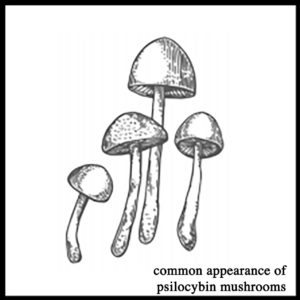
The most diverse species of psilocybin-containing mushrooms live in a magical country just south of the US, Mexico. The late Gastón Guzmán, who was a leading expert in Psilocybes and the first to discover many psilocybin species, estimated there were 55 different species in Mexico alone. However, his daughter, Laura Guzmán Dávalos, also an esteemed mycologist and professor at the University of Guadalajara in Jalisco, Mexico, tells me there may be even more species in less studied parts of the world, like Central and South America as well as Africa. In fact, she explains that although her father identified over 40 species in the Americas, she believes there are more to be found here, especially in remote, tropical jungles. It’s not that far-fetched of an idea considering that many mycologists like Dávalos believe only 3 to 8 percent of the estimated 2.2 to 3.5 million species of fungi have been named and identified at all.
With so many different species of psilocybin mushrooms, are there different magic mushroom experiences? Many psilonauts (those who regularly use magic mushrooms) would argue yes, and indigenous people who use mushrooms ceremonially would probably agree. The indigenous people of the Sierra Mazateca mountain region of Oaxaca, Mexico, believe different mushrooms have their own fuerza, or power. “There are certain species that are more prized and coveted,” Christopher Casuse, who has been working with the Mazatec for over a decade, tells me. For this reason, different species are employed for different ceremonial uses. Many mushroom users outside of the ceremonial context say something similar, that different types of mushrooms have their own “signature”; some create certain types of visual experiences, physical sensations, or have particularly strong introspective effects, for example.
This variance in experience could be due to the slightly different chemical structures of individual species and strains of shrooms. For instance, different species have varying levels of psilocybin and psilocin. And even among one species, strength varies. Psilocybe cubensis, one of the most popular species of psychedelic mushrooms, can have between 0.15 to 1.3 percent psilocybin and 0.11 to 0.5 percent psilocin. And it’s considered “moderately potent.” Plus, there can be many strains of one species of mushroom, especially among cubensis, which are also the most commonly cultivated psilocybin-containing mushrooms. What’s more, homegrown varieties can be stronger than naturally occurring strains due to advanced cultivation techniques.
But beyond psilocybin, there are even more secondary alkaloids produced by mushrooms that could be affecting the experience as well, such as baeocystin and norbaeocystin, though more research is needed to say for sure. It could be very similar to the “entourage effect” theory of the cannabis experience. While THC is the dominant alkaloid that produces the cannabis high, many scientists believe it’s actually the combined effect of the over 400 compounds found in the plant, including other cannabinoids and flavor-producing terpenes.
However, with psilocybin mushrooms, your environment and mind-set going into the experience may play an even larger role in their effect than the chemical composition of the fungi. A concept known as “set and setting” in the psychedelic community can drastically change the mushroom experience, often referred to as the “trip.” We’ll explore these ideas in more depth in later chapters, but they’re important concepts to get familiar with as we begin this journey.
Speaking of environment, Psilocybes grow in a wide variety of settings. While some prefer pastures and cow manure, others thrive on disturbed land in cloud forests. Paul Stamets, a leading authority on psilocybin mushrooms who’s identified a few new species, theorizes why they prefer such habitats in his book and identification guide, Psilocybin Mushrooms of the World. He writes that, before human civilization, psilocybin mushrooms thrived after ecological disasters like landslides, floods, hurricanes, and volcanoes. “This peculiar affection for disturbed habitats enables them to travel, following streams of debris.” Then when humans came into the picture, we were constantly creating ecological disturbances, and so we were the perfect creatures to coevolve with—always creating ideal conditions for shrooms to thrive. Now, psilocybin-containing mushrooms seem to grow at the edge of human civilization, near things like parking lots and graveyards, and they particularly love landscaped areas with mulch, like in front of police stations, causing Stamets to speculate “an innate intelligence on the part of the mushrooms.”
Unlike many other secondary alkaloids produced by plants in nature, scientists still don’t know exactly what evolutionary advantage the production of psilocybin has for mushrooms. Dávalos explains to me that many alkaloids are produced to prevent animals from eating the plant, so that they can continue to survive. However, with psilocybin, it doesn’t seem to be the case, at least not as with other plants, because animals, like deer, still eat psilocybin-containing mushrooms in nature. This has caused many people who have taken them to speculate just the opposite: that psilocybin is produced exactly so animals, especially humans, will consume and experience them. Because of the common trip outcome of returning with a greater appreciation for nature and a stronger urge to protect the planet from contamination, some believe psilocybin is a direct communication link with Mother Nature. And the indigenous people who have used mushrooms ceremonially for centuries believe something similar. Yet, researchers have recently speculated that psilocybin evolved to “mess with insect brains” to protect the mushrooms from attack, because fungi and bugs can compete for the same food, like dung and decaying wood.
Lastly, it’s important to note that psilocybin-containing mushrooms aren’t the only psychoactive mushrooms that produce a trip. The second most famous is Amanita muscaria, also known as the fly agaric, the picturesque, large, red-capped mushroom with white spots. Amanita muscaria and other species of the Amanita genus produce a different psychoactive compound, muscimol, which results in a very distinct trip compared to psilocybin, and one that’s less popular among recreational users. According to Dávalos, one of the main characteristics of its experience is the sensation of being very small while the rest of the world seems huge. It’s the reason many cultures associate this mushroom with elves, gnomes, and dwarves, because it can make you feel like one for a while. Like Psilocybes, Amanitas have also been used ceremonially, for instance, by shamans in ancient Siberian culture. Dávalos tells me there are even more psychoactive mushrooms in nature, but with no known ceremonial uses.
WHY DO PEOPLE USE MUSHROOMS?
Contrary to popular belief, people of all walks of life use mushrooms occasionally for a variety of reasons; their use isn’t limited to hippies and some kind of druggie subculture. I learned this firsthand both interviewing people for this book and attending a psilocybin mushroom retreat where I took the sacred fungi with 17 other people of all age groups and backgrounds, many of whom were previously psychedelic-naïve. But why do 60-year-old grandparents and 29-year-old publicists eat magic mushrooms?
The answers are as individual as the people, but some common themes keep popping up. For one, I continue to hear that mushrooms give people a “reset”; some describe this as an emotional reset, others as a reset on their creativity, but they all use this term that scientists at the Imperial College London have also been exploring in their psilocybin research (more on this in Chapters 3 and 4) . Another popular reason commonly heard in the psychedelic community is eating mushrooms for personal or spiritual growth. This again can mean different things to different people, but the idea is the same: adults using mushrooms with the intention to learn more about themselves and, maybe, become better or happier people. Compared to other psychedelics, mushrooms particularly help people see themselves more clearly, or at least from a new angle, and that can help folks make actionable changes in their lives after their trip.
Of course, not everyone is looking to change their lives or their minds with mushrooms. In fact, according to a survey conducted by longtime psychedelic researcher and author of The Psychedelic Explorer’s Guide, James Fadiman, a large portion of people do mushrooms for fun and out of curiosity. Unlike others in the psychedelic community, I’m not going to say that there’s anything wrong with using mushrooms recreationally, as long as you do so safely and mindfully. If you take the proper precautions like the ones outlined in this book, and you don’t harm anyone else in the process, I believe it’s your right to expand your mind on mushrooms even if the law doesn’t agree. While I am in no way encouraging anyone to do anything illegal, I’m also not trying to contribute to the stigma of these fungi or make them exclusive, inaccessible, or overly medicalized.
In fact, a few recent studies have found that lifetime psychedelic use outside of clinical trials is associated with reduced psychological distress and suicidality in American adults in comparison to users of other drugs—whether that use be recreational, ceremonial, or for personal growth is unknown. This is important because a lot of emphasis is put on doing mushrooms in a controlled environment, like a clinical trial, for positive outcomes, but these studies show that people doing psychedelics at home or in ceremony are also benefiting. However, it’s important to note, modern psychedelic users, or “psychonauts,” are very conscious of ideas like set and setting and have more often than not created their own controlled, safe environments and rituals to ensure safe journeys.
That being said, there’s a lot of talk in the media about psilocybin possibly being a solution to a lot of serious mental health issues like depression, anxiety, post-traumatic stress disorder (PTSD), addiction, and obsessive-compulsive disorder (OCD), among others. While this is real research with serious promise, getting these results at home on your own might be less likely, even after creating a safe environment. If you are looking to do mushrooms for healing, I would highly recommend seeking out professionals to help you do so successfully. There are a few options, like attending retreats abroad, finding an underground therapist, or applying to participate in clinical trials, and I explain each in more depth in Chapter 6.
However, both experts and mushroom enthusiasts attest that mushrooms help us access self-healing or an “inner healing intelligence.” Even a few occasional mushroom users I interviewed for this book spoke of this, like Ashley Manta, sex coach and CannaSexual creator, who primarily uses mushrooms to help her access self-love and acceptance. It’s a use I’m familiar with personally, because mushrooms can help me turn off my inner critics and find love and appreciation for the person I am when everything is stripped away. This same experience is why some people use mushrooms for positivity, reset, anxiety, and even depression. It can also help people who previously thought they had a lack of direction or motivation to find it within themselves. Yet, a big part of using mushrooms for personal growth is “integration,” which we’ll get to in Chapter 11, but the key is remembering these insights and the positive, self-love feelings during your everyday life to help give you strength and confidence.
IS PSILOCYBIN SAFE?
For three years running, the Global Drug Survey has found “magic” psilocybin-containing mushrooms to be the safest “illicit” substance. That’s because mushrooms put the least amount of people in the hospital when compared to other drugs, even LSD. The survey, which is the largest in the world and annually asks over 100,000 people in over 30 countries about their substance use, has continuously found that less than 1 percent of over 10,000 mushroom users seek emergency medical treatment due to their trips. The survey findings also point out that picking and eating mushrooms in nature is riskier than tripping, because misidentification of a poisonous species is known to harm more people per year than psilocybin itself. What’s more, it would be very difficult to overdose on psilocybin, and there have been no recorded fatalities of doing so.
In fact, mushrooms’ relative safety has caused some prominent researchers to suggest that the US government reschedule psilocybin from Schedule I to Schedule IV. At the moment, shrooms are a Schedule I substance in the US, meaning they are considered one of the strongest, most addictive drugs that lacks any sort of medical value. But although, physically, psilocybin is very safe, its mental impact may be another story. Tripping can induce anxiety, bring repressed emotions to the surface, and cause confusion. So that’s how psilocybin can be dangerous: when people become a threat to themselves or others or do thoughtless and risky things while under its influence. However, with proper preparation, special attention paid to a safe supportive environment, and possibly a sitter or guide—all of which we’ll discuss in depth later on in this book—mushrooms can be very safe and rewarding. Plus, according to the Drug Policy Alliance, psilocybin is not addictive and does not trigger compulsive use.
The only other thing that makes mushrooms dangerous is their legal status. Even though Psilocybes grow naturally on every continent, their possession, use, and cultivation is illegal in most countries, including the United States. Therefore, it’s probably more dangerous to be caught with psilocybin mushrooms than it is to ingest them, even though that is beginning to change with recent decriminalization initiatives.
Are magic mushrooms safe? When I ask one of the most prominent and long-standing psychedelic researchers, Bill Richards, who has guided hundreds of journeys, he says it’s very much like skiing or swimming. If you don’t have some guidance and instruction, you can really hurt yourself, but we don’t make skiing illegal. So if you’re planning a magic mushroom trip, read this guide carefully and take its advice to heart. If you adequately prepare for your journey, you should avoid any unnecessarily dangerous situations or outcomes. And you could end up with one of the most meaningful experiences of your life.
_____
Keep reading Your Psilocybin Mushroom Companion
Your Psilocybin Mushroom Companion
Learn. Prepare. Trip. Transform! Get ready to begin the healing process with "magic mushrooms" with this step-by-step guide to safely experimenting with the all-natural psychedelic. With so much misinformation surrounding magic mushrooms out there, it can be hard to separate fact from fiction. This is where Your Psilocybin Mushroom
Learn more